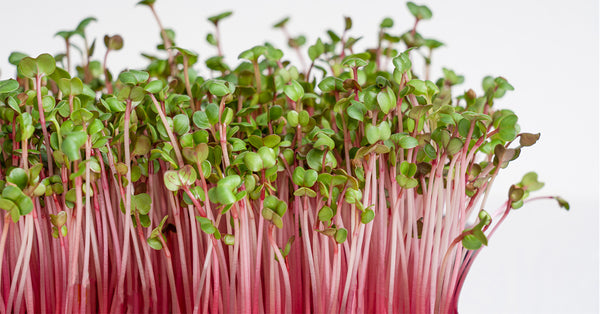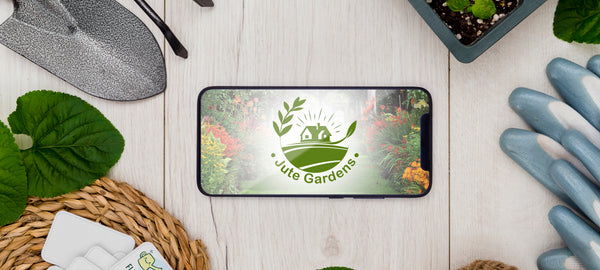
Radish Microgreens: Nutritious and Delicious
The popularity of microgreens is on the rise, as more and more people are discovering the great flavor and nutritional benefits they offer. Radish microgreens are a particularly popular variety, as they offer a nutritional profile that sets them apart from other types of greens.

Radish microgreens are an excellent microgreen variety for first-time growers. They are easy to handle, germinate quickly, grow rapidly, and are easy to harvest. In addition, these microgreens provide intense flavor and a crisp texture to dishes.
What are Radish Microgreens?
Radish microgreens are the baby leaves of the radish plant. They have a slightly spicy flavor and are often used as a garnish or to add a pop of color to a dish. They are a nutritious and delicious way to add flavor and nutrition to your favorite dishes. They are high in antioxidants, vitamins, and minerals.
Versatility
Radish microgreens are a versatile ingredient. They can be used in many different dishes. They have a milder flavor than mature radishes and can be used in salads, sandwiches, wraps, and as a garnish. Adding them to your sandwich or wrap will add color, nutrition, and flavor.
Radish microgreens can also be used in smoothies or juices. In short, they are a nutritional powerhouse that you didn't know you needed.
History and Origin
Radish microgreens were first discovered in the early 1990s by Japanese researchers. They were studying the nutritional benefits of various types of radishes, and they discovered that the microgreens were the most nutrient-dense part of the plant.
Since then, radish microgreens have become popular in Asia and Europe, and they are starting to gain popularity in the United States as well.
Scientific Name
The scientific name for radish microgreens is Raphanus sativus L.
Radish Seeds
Radish seeds are small and round, and they can be white, red, or black.

Types of Radish
There are a variety of different types of radish and therefore radish microgreens. Some of the most common types include:
Red Radish
They have a peppery flavor and are high in antioxidants. They are a good choice for adding color and flavor to salads and wraps.

Daikon Radish
Daikon radish have a milder flavor than other radishes. Daikon radish microgreens are a good choice for adding flavor to smoothies and juices. They are often used in Asian cuisine.

Black Radish
They have a spicy flavor and are high in antioxidants. They are a good choice for adding color and flavor to salads and wraps.

China Rose Radish
The china rose radish is a variety of radish that has pink or reddish-purple skin and white flesh. It is a mild radish with a slightly sweet flavor.

Watermelon Radish
Watermelon radish is a type of radish that has pink or light green skin and white flesh. It has a sweet and refreshing flavor, and it is a good choice for adding color and flavor to salads and wraps.

Cherry Belle Radish
The cherry belle radish is a type of radish that has red skin and white flesh. It has a mild and slightly sweet flavor, and it is a good choice for adding color and flavor to salads and wraps.

Easter Egg Radish
The easter egg radish is a type of radish that has white skin and pink or red flesh. It is small in size and has a mild and slightly sweet flavor.

Nutritional Benefits
Vitamins and Minerals
One of the main reasons radish microgreens are so popular is that they are packed with nutrients. They are a good source of vitamins A, B, and C, as well as potassium, magnesium, and zinc. Radish microgreens are a good source of iron and fiber. They contain more vitamin C than oranges and more vitamin E than spinach. They are also high in antioxidants, which can help protect your cells from damage.
Cruciferous vegetables are a family of vegetables that are high in nutrients and antioxidants. They include broccoli, cauliflower, radish, cabbage, kale, and Brussels sprouts. These vegetables are known for their cancer-fighting properties, and they are a great way to add fiber and vitamins to your diet. Cruciferous vegetables are also low in calories and carbohydrates, making them a healthy choice for people on a weight loss or diabetic diet.
Digestion
Radish microgreens are also a good source of fiber. Fiber is important for good digestion and overall health.
In addition to being nutritionally dense, they are also low in calories and fat-free. One cup of radish microgreens contains only 4 calories and 0 grams of fat. This makes them a great addition to any weight loss or healthy eating plan.
If you are looking for a nutritious and delicious way to add flavor and nutrition to your food, radish microgreens are a great option. They can be added to salads, sandwiches, soups, or any other dish you like.
History of the Radish
The radish, a root vegetable related to the cabbage, has a long and varied history. Radishes were originally grown in China over 4,000 years ago, and from there they spread throughout Asia and Europe. They were popular among the ancient Romans, who used them not only as food but also as medicine.
The modern radish can be traced back to 18th century Germany, where a man named Matthias von Knebel developed a white radish that grew well in cold weather. This variety of radish is still popular today and is known as the “German White” or “Turnip-rooted” radish.
There are many different varieties of radishes available today, including red, white, black, and pink radishes. Radishes can be eaten raw or cooked, and they are often used in salads, stir-fries, and soups. They are also popular in Germany where they are served with butter and salt as a side dish.
Radish microgreens were first discovered in the early 1990s by Japanese researchers. They were studying the nutritional benefits of various types of radishes, and they discovered that the radish microgreens were the most nutrient-dense part of the plant. Since then, they have become popular in Asia and Europe, and they are starting to gain popularity in the United States as well.
How to Grow Radish Microgreens at Home
If you want to try to grow radish microgreens it is surprisingly very easy. All you need is a container, some soil, and a pack of radish microgreens seeds.
Step 1
The first step is to fill your container with soil. You can either use potting soil or garden soil, but make sure the soil is well-drained.
Step 2
Scatter the radish seeds on top of the soil and lightly cover them with a bit of soil.
Step 3
Water the seeds and place the container in a sunny location.
Keep the soil moist but not wet, and within a few days the seeds will germinate and you will start to see radish microgreens growing.

Step 4
Once the greens are about 2 inches tall, you can start harvesting them. Gently pinch off the greens at the base of the plant and discard the rest of the plant.
If you want to keep growing radish microgreens, simply replant more seeds in the same container. You can harvest the greens for several weeks as long as you keep replanting new seeds.
Radish microgreens can be stored in the refrigerator for up to a week. Place them in a plastic bag or container and store them in the crisper drawer. They will stay fresh longer if you keep them moist, so make sure to water them occasionally.
Click here to learn how to grow radish microgreens with a Jute Gardens microgreen kit.
Recipes
Radish microgreens can be added to many different types of dishes. Here are a few recipes that use them:
Salad with Radish Microgreens and Bacon
This recipe is simple but delicious. Start by cooking some bacon until it is crispy, then set it aside to cool. Next, mix together some radish microgreens, bacon, and crumbled blue cheese. Drizzle with a bit of balsamic vinegar or olive oil, and serve.
Radish and Cucumber Salad with Tahini Dressing
This salad is refreshing and healthy. Start by mixing together chopped radishes and cucumbers. In a separate bowl, whisk together tahini, vinegar, garlic, salt, and pepper. Pour the dressing over the salad and toss to combine. Serve chilled.
Roasted Vegetables with Radish Microgreens
This recipe is a great way to use up leftover vegetables from your fridge. Start by chopping up your favorite vegetables into small pieces. Spread the vegetables on a baking sheet, drizzle with olive oil and salt, and roast in the oven until tender. Once they are done, top them with radish microgreens and serve warm.
Jute Gardens offers an excellent recipe for Fresh Rolls with Shrimp, Cucumber, and Radish Microgreens. Fresh and easy, these can be an appetizer, a lunch, or a hand-held snack.
Other Recipe Ideas
- Add them to your favorite salad recipe in place of lettuce or spinach.
- Throw them into your next smoothie for an extra nutrient boost.
- Use them as a garnish on your next homemade soup or chili.
- Top your morning eggs with a sprinkle of microgreens instead of diced onions or chives.
Tips for Harvesting and Using Radish Microgreens
When harvesting, be careful not to damage the plant. Gently pinch off the greens at the base of the plant and discard the rest of the plant.
It is important to wash radish microgreens before eating them to remove any soil or dirt that may be on them. You can either rinse them under cold water or soak them in a bowl of water for a few minutes.
Keep in mind that these microgreens have a slightly spicy flavor, so use them sparingly at first. You may want to start by adding them to dishes that already have a bit of spice to them. As you get used to the flavor, you can add more to your food.
Radish microgreens often get overlooked in favor of more popular leafy greens like kale and spinach. However, what radish microgreens lack in popularity they more than make up for in nutrition. They are packed with vitamins, minerals, and antioxidants, making them a powerful addition to any diet.
So if you're looking for a new leafy green to add to your repertoire, grow radish microgreens and give them a try! Your body will thank you.
Jute Gardens
At Jute Gardens we offer eco-friendly microgreen kits. We have two kits that include radish microgreens - a small and a large kit. Each kit contains everything that you will need to grow organic microgreens at home or at the office.
In addition to packs of seeds, each kit comes with germination trays made from jute fibers, coco pellets, a water sprayer, a green cutter, instructions, and featured recipes.

Germination trays are made from jute which is a renewable resource and it is a naturally porous material. Additionally, these jute fiber germination trays are biodegradable, compostable, and plastic-free, unlike other microgreen kits on the market.
Choose an eco-friendly option to grow radish microgreens in your home or office.
Learn more: Jute Gardens Microgreen Kits.

